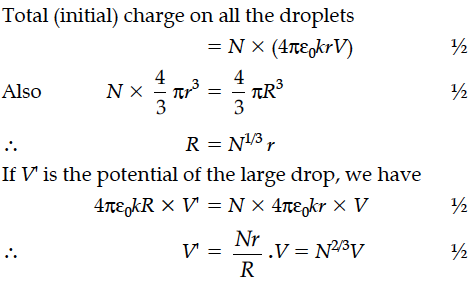N spherical droplets, each of radius r, have been charged to have a potential V each. If all these droplets were to coalesce to form a single large drop, what would be the potential of this large drop ?
(It is given that the capacitance of a sphere of radius x equals
(It is given that the capacitance of a sphere of radius x equals

Twenty-seven drops of mercury are charged simultaneously to the same potential of 10 volts. What will be potential if all the charged drops are made to combine to form one large drop ?
(a) 180 V
(b) 90 V
(c) 120 V
(d) 45 V
Derive an expression for potential due to a dipole for distances large compared to the size of the dipole. How is the potential due to dipole different from that due to single charge ?
Figure shows the field lines due to a positive charge. Is the work done by the field in moving a small positive charge from Q to P, positive or negative? Give reason.
Write two properties of equipotential surfaces. Depict equipotential surfaces due to an isolated point charge. Why do the equipotential surfaces get closer as the distance between the equipotential surfaces and the source charge decreases ?
Two capacitors of capacitance 6 µF and 4 µF are put in series across a 120 V battery. What is the potential difference across the 4 µF capacitor?
(a) 72 V
(b) 60 V
(c) 48 V
(d) zero
A parallel plate capacitor is made by stacking n equally spaced plates connected alternately. If the capacitance between any two plates is C, then the resultant capacitance is
(a) C
(b) nC
(c) (n-1)C
(d) (n+1)C
Two point charges q and –2q are kept d distance apart. Find the location of the point relative to charge q at which potential due to this system of charges is zero.
An electric dipole of length 4 cm, when placed with its axis making an angle of 60° with a uniform electric field, experiences a torque of Nm. Calculate the potential energy of the dipole, if it has charge ± 8 nC.
A small metallic sphere carrying charge +Q is located at the centre of a spherical cavity in a large uncharged metallic spherical shell. Write the charges on the inner and outer surfaces of the shell. Write the expression for the electric field at the point P1.
Three concentric metallic shells A, B and C of radii a, b and c (a < b < c) have surface charge densities +σ, –σ and +σ respectively as shown in the figure.
Two cells of emfs 1.5 V and 2.0 V having internal resistances 0.2Ω and 0.3Ω respectively are connected in parallel. Calculate the emf and internal resistance of the equivalent cell.
The figure shows a series LCR circuit connected to a variable frequency of 200 V source with L = 50 mH, C = 80 µF and R = 40 Ω find.
(i) the source frequency which drives the circuit in resonance;
(ii) the quality factor (Q) of the circuit.
A network of resistors is connected to a 16 V battery with internal resistance of 1 Ω, as shown in the following figure. Compute the equivalent resistance of the network.
The figure shows a plot of terminal voltage ‘V’ versus the current ‘i’ of a given cell. Calculate from the graph
(i) emf of the cell and (ii) internal resistance of the cell.
